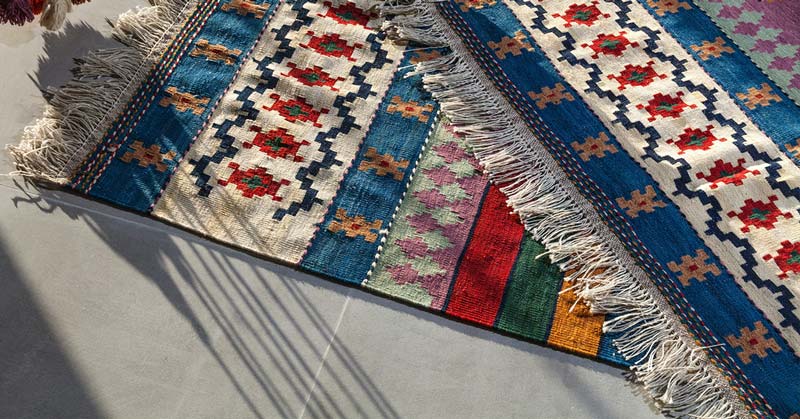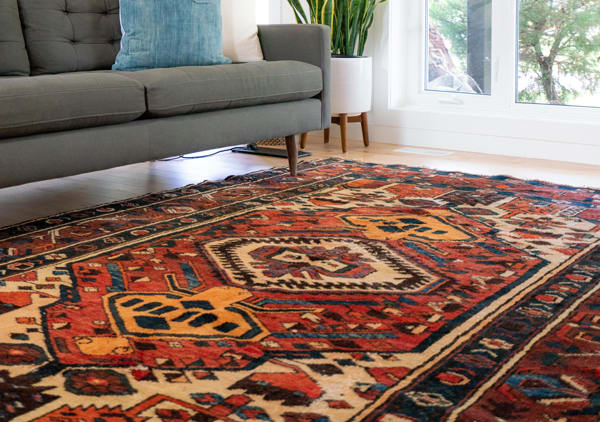Stored area rugs can lose their shape, attract pests and accumulate odors if they’re not put away correctly.
To keep your rug safe and protected, follow these steps to prepare it for storage.
1. Clean the rug thoroughly
To start the rug storage process, give the rug a good vacuuming. Use a good-quality vacuum to ensure you lift as much dander, dust and other microscopic particles as possible. For some valuable area rugs, you’ll need to be much more careful with the vacuum so you don’t ruin the delicate weaving.
Once you’re done vacuuming, clean the rug based on the manufacturer’s specifications. Different cleaning methods may apply depending on the material and make of the rug. First, check the label, then proceed with any of the following methods.
- Woven or braided rugs.
If small braided rugs are washable, place them in a zippered mesh laundry bag and wash them on the gentle cycle and tumble dry on a low setting.
- For large braided rugs, place them on a concrete or vinyl floor. Sponge clean the rug with carpet cleaning foam, rubbing it in according to the directions. Finishby rinsing or vacuuming.
- Handmade, hand-knotted, antique and oriental rugs
Protect your delicate vintage or antique rugs by placing a piece of nylon screen over the rug, and then vacuuming over the screen.
- Coir, sisal, rush and grass rugs.
These natural fiber rugs allow a lot of dirt to sift through to the floor, so be sure to vacuum them regularly.
To clean the rug, scrub any stains with a soft brush and soapy water. Place a plastic cloth beneath it to protect the floor. Blot dry, and use a fan or dryer to speed up the drying process, since water will weaken the fibers.
Some of these rugs are made in squares and are then sewn together. By buying a few extra squares, you can hand-stitch new swatches into the rug if a spot gets ruined.
- Fur, sheepskin and hair-on hides.
To clean these rugs, shake unscented talcum powder on them and then leave it alone for a few hours.
Then, brush the powder through the hair and shake it out, repeating the process several times.
2. Protect the rug from moths and other insects
If you need to store an area rug in a basement, attic or garage, make sure you take extra care to protect it from moths and insects. Apply an insect and moth repellent that is specially designed for fabrics.
3. Tightly roll the rug for storage
Never fold a rug or carpet! Folding can lead to creases, cracks and other damage. Instead, roll the carpet into an even cylinder.
To determine which way to roll your rug, decide which is more fragile: the back of the rug or the pile where the fibers are. In general, the pile is more delicate, meaning you should roll your rug with the pile facing inward.
4. Wrap the rug in a protective fabric
Wrapping a rug is especially helpful if you need to transport or ship it. This extra layer of protection will help keep out bugs, dirt and other elements that can damage the delicate fibers.
How to wrap a rug in a breathable fabric:
- Finish rolling your rug by wrapping a cotton sheet or muslin around the rug at least one and a half times around to keep it protected. Secure the sheet with cotton or polyester twill tape.
- If you want expert-level protection, consider wrapping your rug in a polyurethane rug wrap. These rug wraps are designed to provide a superior barrier against dampness and insects and will be more effective than muslin.
Note: Do not use plastic to wrap your rug, since it will keep it from breathing.
5. Store the rug off the ground in a cool, dry environment
When storing your rug, it’s important to keep it in a location off the ground, safe from any harmful elements.
You’ll also want to make sure nothing else lays on top of it. Boxes and other supplies can cause cracks and destroy the rug’s shape. It is vitally important to store your rug in a cool, dry environment without exposure to natural night.
Keep these rug storage tips in mind:
- Use a fan or dehumidifier to avoid mildew problems.
- Block light from windows with shades or blinds.
- Consistently implement a housekeeping plan (vacuuming, dusting, etc.)
- Store your rug on an elevated surface, since carpet beetles like to reside between the floor and the back of your rug.
6. Unroll and check the rug for signs of damage every few months
To be safe, we also suggest unrolling your rug once a month to make sure there is no evidence of bug infestation. Also, vacuum the area and the rug itself to eliminate any insect-attracting dust.
We offer storage solutions to our clients across Greater Vancouver, Vancouver Island and the Fraser Valley with storage units in Chilliwack (Chilliwack U-Lock Mini Storage), South Surrey and White Rock (White Rock U-Lock Mini Storage), Burnaby and Vancouver (Burnaby U-Lock Mini Storage), Victoria (Victoria U-Lock Mini Storage), Nanaimo (Nanaimo U-Lock Mini Storage) and Parksville (Parksville U-Lock Mini Storage).



